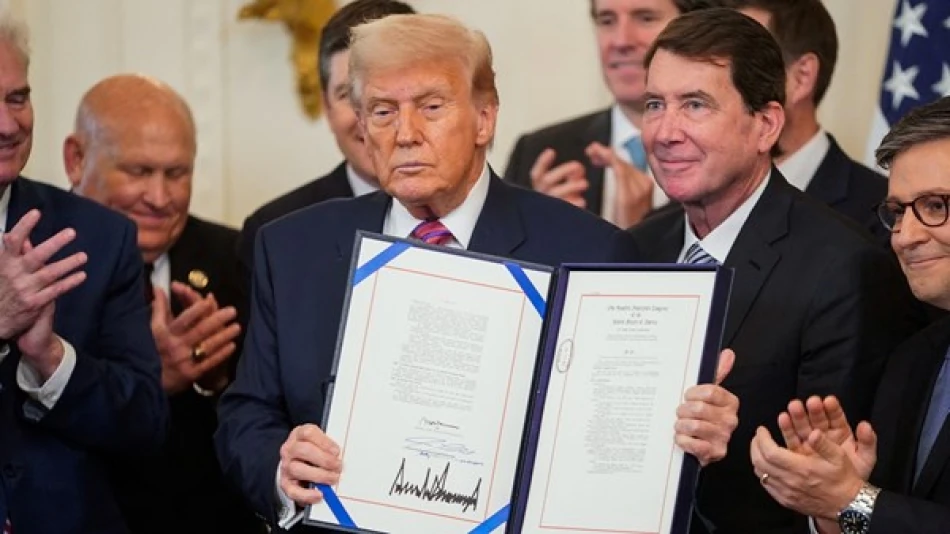
Trump Signs Landmark Cryptocurrency Legislation, Shaping Digital Finance Landscape
Trump Signs Landmark Stablecoin Law, Positioning US as Global Crypto Capital
President Donald Trump has signed groundbreaking legislation establishing the first comprehensive regulatory framework for dollar-pegged stablecoins, marking a pivotal moment in America's bid to dominate the global cryptocurrency landscape. The bipartisan law introduces consumer protections and regulatory clarity for the $200 billion stablecoin market, signaling a dramatic shift from previous regulatory uncertainty to active government support for digital assets.
A New Era of Crypto Regulation
The legislation, which passed both chambers of Congress with overwhelming bipartisan support, creates an initial regulatory framework specifically targeting stablecoins—cryptocurrencies pegged to stable assets like the US dollar to minimize price volatility. This represents the most significant federal crypto legislation since the emergence of digital currencies over a decade ago.
Trump announced the signing on his Truth Social platform Friday morning, celebrating what he called "tremendous achievements" by Republican lawmakers in record time. The move aligns with his broader ambition to make the United States the "crypto capital of the world"—a stark departure from the previous administration's more cautious approach.
Strategic Implications for US Financial Dominance
Competitive Positioning Against Global Rivals
This regulatory clarity puts the US ahead of major competitors in the race for crypto supremacy. While the European Union continues to implement its Markets in Crypto-Assets (MiCA) regulation and China maintains its crypto ban, America is now offering a clear legal pathway for stablecoin innovation. This could attract significant capital and talent from other jurisdictions, particularly from crypto-friendly nations like Singapore and the UAE that have smaller domestic markets.
Market Impact and Investor Confidence
The legislation directly addresses one of the crypto industry's biggest pain points: regulatory uncertainty. Major stablecoin issuers like Tether (USDT) and USD Coin (USDC) have operated in a legal gray area for years, creating compliance headaches and limiting institutional adoption. Clear federal rules should boost investor confidence and potentially unlock billions in institutional capital that has remained on the sidelines.
For traditional financial institutions, this framework provides the regulatory certainty needed to offer stablecoin services without fear of sudden policy reversals. Banks and payment processors can now build long-term strategies around dollar-backed digital currencies.
Consumer Protection in the Digital Age
The law's consumer protection provisions address critical vulnerabilities exposed during previous crypto market turmoil. The collapse of TerraUSD in 2022 and various stablecoin "de-pegging" events highlighted the risks of inadequate backing and transparency. By establishing clear reserve requirements and disclosure standards, the legislation aims to prevent consumer losses while maintaining innovation incentives.
This balanced approach contrasts sharply with more restrictive regulatory responses seen in other countries, where heavy-handed rules have often driven crypto businesses offshore rather than improving consumer safety.
Broader Implications for Digital Finance
Beyond immediate market effects, this legislation signals a fundamental shift in how the US government views cryptocurrency's role in the financial system. Rather than treating digital assets as a threat to traditional banking, the law positions stablecoins as a legitimate part of America's financial infrastructure.
This regulatory embrace could accelerate the development of central bank digital currencies (CBDCs) and programmable money systems, potentially reshaping everything from cross-border payments to government benefit distribution. The dollar's dominance in global trade could be reinforced through widespread adoption of dollar-backed stablecoins, extending American monetary influence into the digital realm.
The timing is particularly significant as global financial systems increasingly digitize and countries compete to establish their currencies as the backbone of digital commerce. By providing regulatory clarity now, the US is positioning itself to capture the lion's share of this emerging market before competitors can establish dominant positions.
Most Viewed News

 Layla Al Mansoori
Layla Al Mansoori






